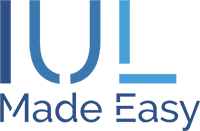Many people think they have to pick between an indexed universal life (IUL) insurance policy and a 401(k). But that’s like deciding whether a soup or a salad makes a better side—they’re made for different tastes.
While both are designed to help you grow wealth for the future, they work differently. Let’s break down the key differences in the IUL vs. 401(k) debate, including tax treatment, risk, flexibility, and long-term benefits, so you can choose which one fits your financial goals.
What Is an IUL?
IUL insurance is a life insurance policy with a twist—it builds cash value based on stock market performance but without the risk of losing so much money in a downturn. With a 0% floor, your policy won’t lose any money due to market volatility, even if the market dips.
It can earn interest from being tied to a market index like the NASDAQ, offering growth potential that’s usually capped at a set value. Meanwhile, your cash value grows tax-deferred, and you can access it through policy loans that are typically tax-free.
Beyond those enticing IUL tax benefits, the plans also provide an income-tax-free death benefit and often include perks like a chronic illness rider, letting you tap into funds early if needed.
What Is a 401(k)?
A 401(k) is a retirement savings plan in which you contribute pre-tax dollars, letting them grow tax-deferred until retirement (age 59½ or later). But once you start withdrawing your money, the IRS takes its cut.
Your money is invested in stocks, bonds, or mutual funds, so it rises and falls with the market, taking a hit when things go south. The best part? Employer matches. If your company offers one, grab it. That’s free money, and skipping it is like tossing out a winning lottery ticket.
How IUL Helps Fix 401(k)’s Weaknesses
A 401(k) has great perks, like employer matches, automatic savings, and high contribution limits. But it’s not without its downsides.
Market volatility means your balance can swing wildly with the stock market. Taxes on your withdrawals can take a big bite out of your savings. And if you need money before age 59 ½, early withdrawals usually come with penalties (plus the taxes you’ll incur).
That’s where IUL offers some balance, with a 0% floor for stability and tax-free access to cash. A 401(k) without an IUL is like a diet of only protein—good but missing some key ingredients for long-term health.
How 401(k) Helps Fix IUL’s Weaknesses
An IUL is a powerful tool—it can act as your own private bank, offering tax-free cash access when needed. But it’s not perfect either.
Higher costs come with the insurance component, making it pricier than a low-fee 401(k). Many of the IUL index strategies come with a growth cap, which in strong bull markets may limit your gains, while a 401(k) captures the full market upswing. IUL requires disciplined, long-term funding, whereas a 401(k) forces savings automatically.
When to Start
- IUL: Wondering how to open an IUL account? Work with an IUL consultant to open an account and start funding it now if you’re looking for tax-deferred growth and more flexibility with access to your money. It’s especially beneficial if you anticipate higher taxes in the future.
- 401(k): The best time to start your 401(k) is as soon as possible, especially if your employer offers a match. That’s essentially free money you don’t want to leave on the table. A 401(k) is a great way to automate your savings and take advantage of compounding growth. Prioritize funding it when you’re ready to commit to long-term retirement savings.
Who Benefits Most
IULs are perfect for middle to high-earners aiming for tax-free future income, especially those who expect higher taxes in the future.
Business owners and self-employed professionals can use IULs to create a financial safety net, while people concerned about market crashes benefit from their stability. If you’re looking for financial flexibility before age 59 ½, an IUL’s access to cash without penalties can be a game changer.
A 401(k) is ideal for employees who want to start saving for retirement easily, especially those with employer matches. It’s an excellent option for anyone looking to take advantage of lower fees. But it’s best suited for people who can stomach losses due to market volatility, who don’t mind locking their money up until retirement, and who are prepared for the tax hit when withdrawing.
The Dos and Don’ts for Your IUL Strategy
- Do: Regularly check your IUL’s performance to adjust your indexing and access strategies. Life changes, and so should your financial approach.
- Don’t: Overborrow or overspend from the cash value—you don’t want to leave yourself short in the future.
- Do: Google “IUL specialist near me” and consult a financial planner before you take any significant action. They’ll make sure you don’t dip into your IUL at the wrong time and risk the future for today’s needs.
Build a Balanced Strategy for the Future
The most effective retirement strategies combine the strengths of IUL and 401(k) plans. Where a 401(k) provides growth with employer matching, an IUL gives you liquidity and protection from market drops.
Using both could help you gain more control over your taxes, reduce your market risk, and increase your financial flexibility. A balanced approach helps you maximize your savings and prepare for the future with the help of IUL Utah experts.
Why limit yourself to one tool when you can harness the power of both?
